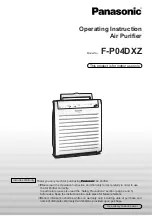
Manual 2100-603
Page
36 of 44
DEFROST CYCLE
The defrost cycle is controlled by temperature and time
on the solid state heat pump control.
When the outdoor temperature is in the lower 40°F
temperature range or colder, the outdoor coil temperature
is 32°F or below. This coil temperature is sensed by the
coil temperature sensor mounted near the bottom of the
outdoor coil. Once coil temperature reaches 30°F or
below, the coil temperature sensor sends a signal to the
control logic of the heat pump control and the defrost
timer will start accumulating run time.
After 30, 60 or 90 minutes of heat pump operation at
30°F or below, the heat pump control will place the
system in the defrost mode.
During the defrost mode, the refrigerant cycle switches
back to the cooling cycle, the outdoor motor stops,
electric heaters are energized, and hot gas passing
through the outdoor coil melts any accumulated frost.
When the temperature rises to approximately 57°F, the
coil temperature sensor will send a signal to the heat
pump control which will return the system to heating
operations automatically.
If some abnormal or temporary condition such as a high
wind causes the heat pump to have a prolonged defrost
cycle, the heat pump control will restore the system to
heating operation automatically after 8 minutes.
The heat pump defrost control board has an option
of 30, 60 or 90-minute setting. By default, this unit
is shipped from the factory with the defrost time on
the 30 minute pin. If circumstances require a change
to another time, remove the wire from the 30-minute
terminal and reconnect to the desired terminal. Refer to
Figure 27.
There is a cycle speed up jumper on the control. This
can be used for testing purposes to reduce the time
between defrost cycle operation without waiting for
time to elapse.
Use a small screwdriver or other metallic object, or
another ¼ inch QC, to short between the
SPEEDUP
terminals to accelerate the HPC timer and initiate defrost.
Be careful not to touch any other terminals with the
instrument used to short the
SPEEDUP
terminals.
It may take up to 10 seconds with the
SPEEDUP
terminals shorted for the speedup to be completed and
the defrost cycle to start.
As soon as the defrost cycle kicks in remove the
shorting instrument from the SPEEDUP terminals.
Otherwise the timing will remain accelerated and run
through the 1-minute minimum defrost length sequence
in a matter of seconds and will automatically terminate
the defrost sequence.
There is an initiate defrost jumper (sen jump) on the
control that can be used at any outdoor ambient during
the heating cycle to simulate a 0° coil temperature.
This can be used to check defrost operation of the unit
without waiting for the outdoor ambient to fall into the
defrost region.
By placing a jumper across the
SEN JMP
terminals
(a ¼ inch QC terminal works best) the defrost sensor
mounted on the outdoor coil is shunted out & will
activate the timing circuit. This permits the defrost
cycle to be checked out in warmer weather conditions
without the outdoor temperature having to fall into the
defrost region.
In order to terminate the defrost test the
SEN JMP
jumper must be removed. If left in place too long, the
compressor could stop due to the high pressure control
opening because of high pressure condition created
by operating in the cooling mode with outdoor fan off.
Pressure will rise fairly fast as there is likely no actual
frost on the outdoor coil in this artificial test condition.
There is also a 5-minute compressor time delay
function built into the HPC. This is to protect the
compressor from short cycling conditions. The board’s
LED will have a fast blink rate when in the compressor
time delay. In some instances, it is helpful to the
service technician to override or speed up this timing
period, and shorting out the
SPEEDUP
terminals for a
few seconds can do this.
Low Pressure Switch Bypass Operation -
The control
has a selectable (SW1) low pressure switch bypass set
up to ignore the low pressure switch input during the
first (30, 60, 120 or 180 seconds) of “Y” operation.
After this period expires, the control will then monitor
the low pressure switch input normally to make sure
that the switch is closed during “Y” operation.
High Pressure Switch Operation -
The control has a
built-in lockout system that allows the unit to have the
high pressure switch trip up to two times in one hour
and only encounter a “soft” lockout. A “soft” lockout
shuts the compressor off and waits for the pressure
switch to reset, which at that point then allows the
compressor to be restarted as long as the 5-minute short
cycle timer has run out. If the high pressure switch
trips a third time within one hour, the unit is in “hard”
lockout indicating something is certainly wrong and it
will not restart itself.
Содержание Q-TEC Q24H2D Series
Страница 6: ...Manual 2100 603 Page 6 of 44 FIGURE 1 UNIT DIMENSIONS Q24H2D Q60H2D Q30H2D Q36H2D Q42H2D Q48H2D...
Страница 9: ...Manual 2100 603 Page 9 of 44 FIGURE 6 DUCTED APPLICATION FIGURE 5 INSTALLATION WITH DUCT FREE PLENUM...
Страница 13: ...Manual 2100 603 Page 13 of 44 MIS 2469 DRAIN BOX WALL SLEEVE OVERFLOW TUBE CAULK AROUND TUBE FIGURE 12A...
Страница 15: ...Manual 2100 603 Page 15 of 44 REMOVE KNOCK OUT FOR INDOOR DRAIN HOSE CONNECTOR MIS 2471 FIGURE 12C If Used...
Страница 31: ...Manual 2100 603 Page 31 of 44 FIGURE 22 FRESH AIR DAMPER REMOVAL MOUNTING SCREW...









































